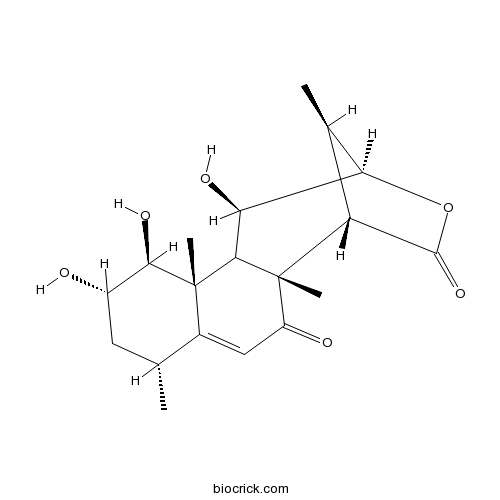Eurycomalide ACAS# 677291-51-9 |

Quality Control & MSDS
3D structure
Package In Stock
Number of papers citing our products

| Cas No. | 677291-51-9 | SDF | Download SDF |
| PubChem ID | 102004691 | Appearance | Powder |
| Formula | C19H26O6 | M.Wt | 350.4 |
| Type of Compound | Diterpenoids | Storage | Desiccate at -20°C |
| Solubility | Soluble in Chloroform,Dichloromethane,Ethyl Acetate,DMSO,Acetone,etc. | ||
| SMILES | CC1CC(C(C2(C1=CC(=O)C3(C2C(C4C(C3C(=O)O4)C)O)C)C)O)O | ||
| Standard InChIKey | ROIUBSDBUACGGP-CTGWBADSSA-N | ||
| Standard InChI | InChI=1S/C19H26O6/c1-7-5-10(20)16(23)18(3)9(7)6-11(21)19(4)12-8(2)14(25-17(12)24)13(22)15(18)19/h6-8,10,12-16,20,22-23H,5H2,1-4H3/t7-,8-,10+,12-,13+,14-,15?,16-,18+,19+/m1/s1 | ||
| General tips | For obtaining a higher solubility , please warm the tube at 37 ℃ and shake it in the ultrasonic bath for a while.Stock solution can be stored below -20℃ for several months. We recommend that you prepare and use the solution on the same day. However, if the test schedule requires, the stock solutions can be prepared in advance, and the stock solution must be sealed and stored below -20℃. In general, the stock solution can be kept for several months. Before use, we recommend that you leave the vial at room temperature for at least an hour before opening it. |
||
| About Packaging | 1. The packaging of the product may be reversed during transportation, cause the high purity compounds to adhere to the neck or cap of the vial.Take the vail out of its packaging and shake gently until the compounds fall to the bottom of the vial. 2. For liquid products, please centrifuge at 500xg to gather the liquid to the bottom of the vial. 3. Try to avoid loss or contamination during the experiment. |
||
| Shipping Condition | Packaging according to customer requirements(5mg, 10mg, 20mg and more). Ship via FedEx, DHL, UPS, EMS or other couriers with RT, or blue ice upon request. | ||
| Description | Standard reference |
| In vitro | Cytotoxic and antimalarial constituents from the roots of Eurycoma longifolia.[Pubmed: 14738962]Bioorg Med Chem. 2004 Feb 1;12(3):537-44.
|

Eurycomalide A Dilution Calculator

Eurycomalide A Molarity Calculator
| 1 mg | 5 mg | 10 mg | 20 mg | 25 mg | |
| 1 mM | 2.8539 mL | 14.2694 mL | 28.5388 mL | 57.0776 mL | 71.347 mL |
| 5 mM | 0.5708 mL | 2.8539 mL | 5.7078 mL | 11.4155 mL | 14.2694 mL |
| 10 mM | 0.2854 mL | 1.4269 mL | 2.8539 mL | 5.7078 mL | 7.1347 mL |
| 50 mM | 0.0571 mL | 0.2854 mL | 0.5708 mL | 1.1416 mL | 1.4269 mL |
| 100 mM | 0.0285 mL | 0.1427 mL | 0.2854 mL | 0.5708 mL | 0.7135 mL |
| * Note: If you are in the process of experiment, it's necessary to make the dilution ratios of the samples. The dilution data above is only for reference. Normally, it's can get a better solubility within lower of Concentrations. | |||||

Calcutta University

University of Minnesota

University of Maryland School of Medicine

University of Illinois at Chicago

The Ohio State University

University of Zurich

Harvard University

Colorado State University

Auburn University

Yale University

Worcester Polytechnic Institute

Washington State University

Stanford University

University of Leipzig

Universidade da Beira Interior

The Institute of Cancer Research

Heidelberg University

University of Amsterdam

University of Auckland

TsingHua University

The University of Michigan

Miami University

DRURY University

Jilin University

Fudan University

Wuhan University

Sun Yat-sen University

Universite de Paris

Deemed University

Auckland University

The University of Tokyo

Korea University
- Rediocide C
Catalog No.:BCN4233
CAS No.:677277-98-4
- Apigenin 6-C-alpha-L-arabinopyranosyl-8-C-beta-D-xylopyranoside
Catalog No.:BCN7820
CAS No.:677021-30-6
- Anhydroglycinol
Catalog No.:BCN4053
CAS No.:67685-22-7
- (±)-trans-ACPD
Catalog No.:BCC6567
CAS No.:67684-64-4
- 8alpha-(2-Methylacryloyloxy)hirsutinolide 13-O-acetate
Catalog No.:BCN7107
CAS No.:67667-71-4
- De-O-methylacetovanillochromene
Catalog No.:BCN4232
CAS No.:67667-62-3
- Syringylpropane
Catalog No.:BCN3540
CAS No.:6766-82-1
- 1-Azakenpaullone
Catalog No.:BCC5332
CAS No.:676596-65-9
- 9-Hydroxycamptothecin
Catalog No.:BCC8276
CAS No.:67656-30-8
- Methylenetanshinquinone
Catalog No.:BCN3156
CAS No.:67656-29-5
- Clerodermic acid methyl ester
Catalog No.:BCN4231
CAS No.:67650-47-9
- 5,7,2'-Trihydroxyflavanone
Catalog No.:BCC9241
CAS No.:120980-68-9
- TG100-115
Catalog No.:BCC1247
CAS No.:677297-51-7
- iCRT 14
Catalog No.:BCC5401
CAS No.:677331-12-3
- PIK-90
Catalog No.:BCC1248
CAS No.:677338-12-4
- 2-(2,4-Dihydroxyphenyl)-6-hydroxybenzofuran
Catalog No.:BCN7546
CAS No.:67736-22-5
- Menisdaurin
Catalog No.:BCN2552
CAS No.:67765-58-6
- MRK 560
Catalog No.:BCC2345
CAS No.:677772-84-8
- 2,3,2'',3''-Tetrahydroochnaflavone
Catalog No.:BCN4234
CAS No.:678138-59-5
- Methyl 2,4-dihydroxyphenylacetate
Catalog No.:BCN6801
CAS No.:67828-42-6
- Ethyl 2,4-dihydroxyphenylacetate
Catalog No.:BCN4235
CAS No.:67828-62-0
- Taraxasterone
Catalog No.:BCN7746
CAS No.:6786-16-9
- Boc-Nva-OH.DCHA
Catalog No.:BCC2642
CAS No.:67861-96-5
- Caftaric acid
Catalog No.:BCN2096
CAS No.:67879-58-7
Cytotoxic and antimalarial constituents from the roots of Eurycoma longifolia.[Pubmed:14738962]
Bioorg Med Chem. 2004 Feb 1;12(3):537-44.
Sixty-five compounds were isolated from the roots of Eurycoma longifolia and characterized by comprehensive analyses of their 1D and 2D NMR, and mass spectral data. Among these isolates, four quassinoid diterpenoids were reported from natural sources for the first time, namely Eurycomalide A (1), eurycomalide B (2), 13beta, 21-dihydroxyeurycomanol (3), and 5alpha, 14beta, 15beta-trihydroxyklaineanone (4). Screening of cytotoxicity, anti-HIV and antimalarial activity of these isolated compounds was also furnished by in vitro assays. Compounds 12, 13, 17, 18, 36, 38, 59, and 62 demonstrated strong cytotoxicity toward human lung cancer (A-549) cell lines, however, 12, 13, 17, 38, 57, 58, and 59 exhibited strong cytoxicity toward human breast cancer (MCF-7) cell lines. Compounds 57 and 58 displayed potent antimalarial activity against the resistant Plasmodium falciparum. The thorough studies on the stereochemistry of the different quassinoid diterpenoids provide a clear reference to the scientists who are interested on this field.


